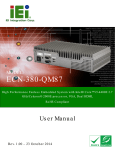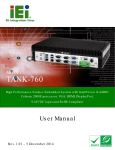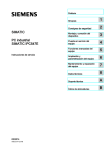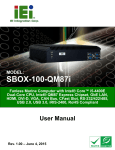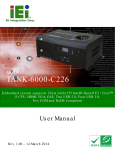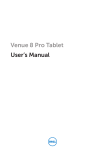Download DELL XPS 1820
Transcript
Dell™ XPS 18 User’s Manual Computer Model: XPS 1820 Regulatory Type : W01A Regulatory Model: W01A002 Notes, Cautions, and Warnings NOTE: A NOTE indicates important information that helps you make better use of your computer. CAUTION: A CAUTION indicates potential damage to hardware or loss of data if instructions are not followed. WARNING: A WARNING indicates a potential for property damage, personal injury, or death. Copyright © 2014 Dell Inc. All rights reserved. This product is protected by U.S. and international copyright and intellectual property laws. Dell™ and the Dell logo are trademarks of Dell Inc. in the United States and/or other jurisdictions. All other marks and names mentioned herein may be trademarks of their respective companies. 2014 - 04 Rev. A00 Contents Features ��������������������������������������������������������������������������������� 5 Accessories ��������������������������������������������������������������������������� 9 Setting Up Your Computer�������������������������������������������������11 Charging Your Computer���������������������������������������������������������������11 Turning On Your Computer�����������������������������������������������������������13 Enabling/Disabling Wi-Fi �������������������������������������������������������������� 14 Connecting to a Network�������������������������������������������������������������� 14 Inserting a Memory Card (Sold Separately) — Optional �����������������������������������������������������������������������������������������15 Removing the Memory Card�������������������������������������������������������� 16 Using Your Computer ��������������������������������������������������������17 Screen Orientation���������������������������������������������������������������������������17 Windows Start Screen���������������������������������������������������������������������17 Gestures��������������������������������������������������������������������������������������������� 18 Using Headphone/Microphone �������������������������������������������������� 23 Turning Off the Screen ������������������������������������������������������������������ 24 Turning Off Your Computer���������������������������������������������������������� 24 Synchronizing Your Computer using a Microsoft account ���������������������������������������������������������� 26 Contents │ 3 Powered Stand ������������������������������������������������������������������� 27 Features���������������������������������������������������������������������������������������������� 27 Using the Powered Stand�������������������������������������������������������������� 29 Docking Your Computer ��������������������������������������������������������������� 30 Undocking Your Computer �����������������������������������������������������������31 Cleaning Your Computer��������������������������������������������������� 32 Troubleshooting ���������������������������������������������������������������� 33 Locating Your Service Tag and Express Service Code ������������������������������������������������������������������������������������ 39 Specifications ���������������������������������������������������������������������40 4 │Contents Features This section provides information about the features available on your computer. 3 2 1 4 5 6 7 8 9 10 Feature 1 Ambient-light sensor 2 Front-facing camera 3 Camera-status light 4 Volume-control buttons (2) 5 Left speaker 6 Media-card reader Functionality Detects the ambient light and automatically adjusts the display brightness. Capture a front-view picture or record videos. Make video calls with web applications, such as Skype. Turns on when the camera is in use. Press to increase or decrease the volume. Provides audio output. Reads from and writes to media cards Features │ 5 Feature 7 Headset/speaker port 8 USB 3.0 ports (2) 9 Power-adapter port 10 Windows button 6 │Features Functionality Connect a headphone, a headset (headphone and microphone combo), or speakers. Connect peripherals such as storage devices, printers, and so on. Provides data transfer speeds up to 5 Gbps. Connect a power adapter to provide power to your computer and charge the battery. Press to go to the Start screen while an app is active. Press for quick access to the most recently used app or most recently viewed screen. 1 2 3 4 5 6 Feature 1 Power/Battery-status light 2 Power button 3 Right speaker 4 Security-cable slot 5 Touchscreen display 6 Docking port Functionality Indicates the power/battery-charge status. (For more information, see “Battery-status light:”). Turn on your computer or change the power state of your computer. Provides audio output. Connect a security cable to prevent unauthorized movement of your computer. Touch the display to use on-screen controls including buttons, menu items, and the on-screen keyboard Connect to a Dell Powered-Stand (sold separately). Features │ 7 1 Feature Left and right feet Functionality Fold the feet outward to allow your computer to stand upright in landscape mode. Fold inward to allow your computer to lay flat. CAUTION: Do not place or use the computer in portrait mode. 8 │Features Accessories ∞∞ Power adapter and cable — Provides power to your computer and charges the battery. ∞∞ USB to ethernet adapter (sold separately) — Allows you to connect a RJ45 (network) cable to your computer using a USB port. ∞∞ Powered stand (sold separately) — Allows your computer to be placed upright. It also allows adjusting the viewing angle and charges the battery. Accessories │ 9 ∞∞ Wireless keyboard and mouse (sold separately) - Inputs text and controls the cursor. NOTE: If you order the keyboard and mouse along with your computer, they are already paired when you receive them. If you purchase the keyboard and mouse separately, or if you need to pair them again, see “Pairing the wireless keyboard and mouse”. 10 │Accessories Setting Up Your Computer WARNING: Before you begin any of the procedures in this section, read the safety information that shipped with your computer. For more best practices information, see dell.com/regulatory_compliance. NOTE: You receive your computer in shipping mode to prevent it from accidentally turning on during shipping. To turn on your computer for the first time, connect the power adapter and then press the power button. Charging Your Computer NOTE: The battery is not fully charged when you first receive your computer. Your computer cannot be charged using a USB cable. 1 Connect the power cable to the power adapter. 2 Connect the power adapter to your computer. 3 Connect the power adapter into an electrical outlet and charge your computer until the battery is fully charged. NOTE: A completely discharged battery takes 4-5 hours to charge fully while the computer is turned off. The battery charge light on the right side of your computer turns off once the battery is fully charged. Setting Up Your Computer │ 11 Battery-status light: You can check the charge/power status of your computer by checking the battery-status light on the side of your computer or the icon on the screen when your computer is turned on. Solid white light Power adapter is connected to the computer and the battery is being charged. Solid amber light Battery charge is low or critical. Off Power adapter is connected to the computer and battery is fully charged or power adapter is not connected to the computer. Battery icon displayed on the screen: Battery icon Description Battery is fully charged Battery is charging Computer is running on battery power and the battery is discharging. Computer is plugged in, and either no battery is detected, or the battery isn’t working correctly. Battery is low Battery is critically low NOTE: You can check exact battery charge by hovering the mouse pointer over the battery icon. 12 │Setting Up Your Computer Turning On Your Computer CAUTION: Use your computer in an ambient temperature between 0°C and 35°C (32°F and 95°F). 1 Press and release the Power and Sleep/Wake button . NOTE: After the button is pressed, there is a slight delay before your computer turns on or off. 2 Finish Windows setup by selecting your options for personalization, signing into your Microsoft account or creating a local account, and so on. a. Enable security and updates. b. Connect to your wireless network. Setting Up Your Computer │ 13 c. Sign in to your computer. Your computer is ready for use when the Windows Start screen is displayed. NOTE: A lock screen may be displayed when your computer wakes up from a sleep state. NOTE: If the login screen is not enabled, the Start screen appears after you swipe-up on the lock screen. Enabling/Disabling Wi-Fi 1 Swipe from the right edge of the display to access Charms. 2 Touch Settings → Change PC settings→ Wireless. 3 Move the slider to the right to enable Wi-Fi. Move the Wi-Fi slider to the left to disable Wi-Fi. Connecting to a Network 1 Swipe from the right edge of the display to access Charms. 2 Touch Settings → Available → Select an available network→ Connect. NOTE: If you need to connect to another network later, tap in the Charms sidebar and select the network you want to connect to. 14 │Setting Up Your Computer Inserting a Memory Card (Sold Separately) — Optional 1 Orient the SD card so that the pins on the card are facing the rear when inserted. 2 Push the slot cover down. 3 Push the SD card into the slot until it clicks into place. For more information, see “Media-card reader” in Specifications. Setting Up Your Computer │ 15 Removing the Memory Card 1 2 3 4 5 CAUTION: To avoid data loss, ensure all read/write operations to the memory card are complete before removing it from the computer. Tap the Desktop tile to access the Desktop mode. In the notification area at the bottom-right corner of the screen , tap the safely remove hardware icon . NOTE: If you don not see Safely Remove Hardware , tap Show Hidden Icons to display all icons in the notification area. Tap the memory card name in the list. A message appears confirming that the memory card can be safely removed. NOTE: If a warning message appears stating the memory card cannot be removed, make sure all data transfers to and from the memory card are complete and try again. Push the memory card inward to release it from the slot. Pull the memory card out of the slot. 16 │Setting Up Your Computer Using Your Computer Screen Orientation For optimal viewing experience, the screen orientation changes automatically to portrait or landscape mode depending on your computer’s orientation. Automatic screen rotation is enabled by default. NOTE: Some applications may not support automatic screen rotation. Disabling or enabling automatic screen rotation: 1 Swipe from the right edge of the display to access Charms. 2 Tap Settings → Screen . 3 Tap or to toggle automatic screen rotation. Windows Start Screen The Windows Start screen displays a list of default and custom Live Tiles, which act as shortcuts to various installed applications. Live Tiles on your Start screen update in real time with information on news, sports, weather, stocks, social networks, and so on. The tile‑based user interface gives you direct access to your most recently used applications, emails, photos, music, videos, contacts, social media updates, and frequently viewed websites. You can pin your favorite apps as tiles for easy access. NOTE: You can add or remove Live Tiles by using Pin or Unpin options. Accessing the desktop To access the desktop interface — like in the previous versions of Windows — tap or click the Desktop tile on the Start screen. Accessing the Start screen ∞∞ Press the Windows button ∞∞ Swipe from the right edge of the display to access Charms, and then tap the Start icon . NOTE: The Start icon in the Charms sidebar and the Windows button on your computer have the same functionality. Using Your Computer │ 17 Getting more information on Windows You can get more information on Windows and the new features using any of the following resources: ∞∞ dell.com/windows8 ∞∞ dell.com/support ∞∞ Help+Tips tile Gestures Your computer has a multi-point touch display that allows you to perform common tasks using gestures. Finger gestures Tap/Dwell Allows you to: Tap gently on the screen with your fingertip to select an item, launch apps, and so on. Touch and hold the item on the screen to open the context menu. 18 │Using Your Computer Finger gestures Zoom Allows you to: Place two fingers on the touchscreen and then move them apart to zoom-in. Place two fingers on the touchscreen and then move them apart to zoom-out. Flick Move a finger quickly in the desired direction to flip through content in the active window like pages in a book. Flick also works vertically when navigating content such as images or songs in a play‑list. Using Your Computer │ 19 Finger gestures Rotate Allows you to: Rotate clockwise — Keeping a finger or thumb in place, move the other finger in an arched direction to the right Rotate counter-clockwise — Keeping a finger or thumb in place, move the other finger in an arched direction to the left You can also rotate the active content by moving both the fingers in a circular motion. Scroll Pan – Move the focus on the selected object when the entire object is not visible. Move two fingers in the desired direction to pan the selected object. Scroll Vertical – Scroll up or scroll down on the active window. Move a finger up or down to start vertical scrolling. Scroll Horizontal – Scroll right or left on the active window. Move a finger to the right or left to start horizontal scrolling. 20 │Using Your Computer Using Keyboard and Mouse If you purchased a wireless keyboard and mouse with your computer, they will be already paired. To use the keyboard and mouse, make sure the batteries are installed in both devices and they are powered on. Using Your Computer │ 21 Pairing the wireless keyboard and mouse If the keyboard and mouse do not work automatically or if the pairing is lost for some reason, manually pair them with your computer. To pair the keyboard and mouse: 1 Swipe from the right edge of the display to access Charms. 2 Touch Settings → Change PC Settings→ Devices→ Add a device. 3 Select the keyboard and tap Pair. 4 Once the keyboard has paired, select the mouse and tap Pair. NOTE: The wireless keyboard and mouse may ship with a USB dongle. You do not need to install the dongle to use the wireless keyboard and mouse on this computer. 22 │Using Your Computer Using Headphone/Microphone Your computer has a headset port that supports a headphone, a microphone, or a headset device to listen to music, record audio, or make voice calls. WARNING: Listening to loud music for extended periods of time can lead to hearing loss. NOTE: It is recommended to keep the volume level low before connecting the headphones to your computer. 1 Connect headphones to the headset port. 2 Insert the headphones in your ears and adjust the volume level to a comfortable level. NOTE: The integrated speakers on your computer are muted automatically when you connect an audio device to the headset port. CAUTION: To prevent damage to the headphones when disconnecting them from your computer, pull the connector and not the cable. Using Your Computer │ 23 Turning Off the Screen Using the power button: Press and release the Power and Sleep/Wake button to turn off the screen. Using Charms: Swipe from the right edge of the display to access Charms. Touch Settings → Power → Sleep to turn off the screen. NOTE: If your computer is in a sleep state (computer is on, but screen is off), press the Power and Sleep/Wake button or Windows button once to turn on the screen. Turning Off Your Computer Swipe from the right edge of the display to access Charms. Touch Settings → Power → Shut down to turn off the computer. 24 │Using Your Computer Hotkeys You can access various menus on your computer using the following hotkeys: Menu Boot menu BIOS/System setup ePSA menu LCD BIST menu Key combination Press and release the volume-up and the power button. Press and release the volume-down and the power button. Press and hold down the volume up and power buttons for 2 seconds then release the volume-up and the power button. Press and hold down the volume down and power buttons for 2 seconds then release the volume-down and the power button. Menu descriptions: ∞∞ Boot menu — A special menu that allows you to run ePSA diagnostics or boot from a device other than the internal hard drive. ∞∞ BIOS / System setup menu — Allows you to access the BIOS setup mode to review more advanced system information and configure system settings. ∞∞ ePSA menu — Starts the Enhanced Pre-Boot System Assessment. It allows you to access detailed system information and perform diagnostics on the computer hardware. ∞∞ LCD BIST menu — Launches the Built-in Self Test (BIST) that allows you to diagnose a display-related problem. NOTE: For more information on the tools available to keep your computer running properly, see dell.com/support. Using Your Computer │ 25 Synchronizing Your Computer using a Microsoft account When you sign-in to your computer using a Microsoft account, you can automatically synchronize your settings, such as installed apps, theme, wallpaper, internet browser history, application settings, personal files, and so on, with other Windows 8/8.1 computers that use the same Microsoft account. 1 Swipe from the right edge of the display to access Charms, then click Settings → Change PC Settings→ Users→ Switch to a Microsoft account to switch to your Microsoft account. 2 Click Settings → Change PC Settings→ Sync your settings to configure synchronization options. 26 │Synchronizing Your Computer using a Microsoft account Powered Stand Features 2 1 Feature 1 Docking-status light 2 Docking connector Functionality Turns on when your computer is successfully docked (if the power adapter is attached to the powered stand). Connects the computer to the docking port to provide power to your computer and charge the battery. Docking-Status Light Behavior Behavior White Off Description Computer is docked in the powered stand and the power adapter is connected to the stand. Computer is not docked, or the power adapter is not connected to the stand. Powered Stand │ 27 1 2 3 Feature 1 Hinge 2 Power-adapter port 3 Cable clip Functionality Allows you to adjust the angle of your computer between 10 degrees and 70 degrees. Connect the power adapter to provide power to the computer, and charge the battery. Holds the power-adapter cable in place. 70° 10° 28 │Powered Stand Using the Powered Stand Connecting the Power Adapter to the Stand CAUTION: Use only the supplied power adapter and power cable. Using unauthorized adapters or cables may severely damage your computer and stand. 1 Connect the power adapter to the power-adapter port on the stand. 2 Connect the power adapter to an electrical outlet. Powered Stand │ 29 Docking Your Computer 1 Connect power adapter to the stand. 2 Connect the power adapter to an electrical outlet. 3 Align the docking port on your computer to the docking connector on the powered stand. 4 Place your computer on the powered stand. NOTE: The docking status light turns on when your computer is correctly seated on the powered stand and the powered stand is connected to a power source. For more information, see “Docking-Status Light Behavior”. 30 │Powered Stand Undocking Your Computer Lift the computer from the powered stand. Powered Stand │ 31 Cleaning Your Computer CAUTION: Disconnect all cables from your computer before cleaning it. Clean your computer with a soft cloth slightly moistened with water or an approved display cleaner. Do not use liquid or aerosol cleaners that may contain flammable substances. 1 Turn off your computer. For more information on turning off your computer, see Turning Off Your Computer. 2 Moisten a soft, lint-free cloth with either water or a display cleaner, and wipe the surface of the computer until it is clean. Do not allow liquid from the cloth to seep into the computer ports. NOTE: Do not spray cleaning solution directly onto the computer. Only use specifically-designed cleaning products, and follow the instructions that are included with the product. 32 │Cleaning Your Computer Troubleshooting Windows Troubleshooting and Recovery Refreshing your computer Refreshing your computer restores Windows to the original factory settings without deleting any of your personal files, installed applications, or personalization settings. CAUTION: Refreshing your computer removes all third-party applications. 1 Swipe from the right edge of the display to access Charms. 2 Touch Settings → Change PC settings→ General→ Refresh your PC without affecting your files. 3 Touch Get started. 4 Read the instructions on the screen and touch Next. Resetting your computer Resetting your computer returns Windows to original factory settings and removes any settings, files, and applications you installed after you received your computer. CAUTION: Resetting your computer erases all data from your computer, including your apps, account configuration, music, pictures, files, and so on. Ensure that you back up all the required data before you proceed. 1 Swipe from the right edge of the display to access Charms. 2 Touch Settings → Change PC settings→ General→ Remove everything and reinstall Windows. 3 Touch Get started. 4 Read the instructions on the screen and touch Next. Troubleshooting │ 33 Using advanced startup Use advanced startup if you have problems starting up your computer or if you want to change the computer’s startup settings, such as allowing your computer to start up from a USB device or an optical media. 1 Swipe from the right edge of the display to access Charms. 2 Touch Settings → Change PC settings→ General→ Advanced startup→ Restart now. 3 Touch the Troubleshoot option to configure various startup settings. 34 │Troubleshooting Battery Problems Problems Battery does not charge Possible causes •Your computer is not properly plugged into a power source. •You are using an incorrect power adapter/cable. •The power outlet is not working. •The power adapter/ cable is loose. The computer temperature is lower than 0 °C or higher than 35°C. The battery or power adapter is damaged. Possible solution •Use the supplied power adapter and power cable. •Unplug the power adapter from the wall and verify that the outlet is functioning. •Unplug the cables from the wall outlet and the computer, check all connections,then plug the cables back to the wall outlet and then to the computer. •Verify that the light on the power adapter is on. If it is not on, unplug and re-plug the power adapter and/or try another outlet that is known to work. If the light still does not turn on, try replacing the power adapter Charge the battery in an ambient temperature between 0°C and 35°C. Contact Dell or the manufacturer to replace the damaged parts. Troubleshooting │ 35 System problem Problems Computer does not turn on Computer is not responding or behaving unexpectedly Possible causes The battery is completely discharged. Your computer could be in an unresponsive or locked state. Possible solution Connect your computer to a power source using the power adapter. Press and hold the power button for 11 seconds to perform a hard shutdown, then press the power button to turn the computer back on. Your computer may Computers shipped from be in shipping mode. the factory are set in This is to avoid the shipping mode. To get computer from being out of this mode, plug accidentally turned the power adapter to a on during shipping wall outlet and then to and draining the computer and press the battery. power button to turn on the computer. After the initial power up, the computer behaves as normal. Your computer could 1 Reboot the computer. be in an unresponsive See Turning Off Your or locked state. Computer and Turning On Your Computer. 2 Refresh your computer. See Refreshing your computer. 3 Reset your computer. See Resetting your computer. 4 Contact Dell’s support service. Go to dell. com/support or dell.com/ContactDell. 36 │Troubleshooting Problems Software or feature is not working as expected Possible causes The application or feature could be in an unresponsive state. Possible solution Software updates may have been downloaded in the background. Restart your computer. Touchscreen problem Problems Touchscreen responds slowly or improperly Possible causes Possible solution The display may be •Clean the display. dirty or you may See “Cleaning your need to adjust display computer”. settings. •Adjust display settings in Windows Desktop, Control Panel→ Appearance and Personalization→ Display. Troubleshooting │ 37 Network problem Problems No wireless connection Possible causes Your computer is not able to properly access a wireless signal. Possible solution 1 Check if the wireless radio is on. See Enabling/Disabling Wi-Fi. 2 Move closer to the wireless access point. 3 Reset the wireless router if using a private network. 4 Open the browser to view the landing page if using a public network, and follow the instructions given by the public network. Slow Internet connections 5 Try another wireless connection. The signal strength is 1 Move your computer to not strong enough. a different location for better signal reception. 2 Contact your Internet Service Provider. 38 │Troubleshooting Locating Your Service Tag and Express Service Code You need your computer’s Service Tag/Express Service Code when you contact Dell for technical support or other queries. The Express Service Code helps the automated telephone support system redirect your call to the appropriate support department. The Service Tag and Express Service Code for your computer are located on a label at the back of your computer. CAUTION: Lay your computer face-down on a soft, clean surface down before you look for the Service Tag and Express Service Code. Troubleshooting │ 39 Specifications System Information Computer model XPS 1820 Physical dimensions Height 283.70 mm (11.17 in) Width 463.60 mm (18.25 in) Depth 17.70 mm (0.70 in) Weight: Weight (maximum) 2.41 kg (5.31 lb) Stand weight 2.05 kg (4.52 lb) Hardware Processor •Intel Core i3 ULV (4th generation) •Intel Core i5 ULV (4th generation) •Intel Core i7 ULV (4th generation) Chipset Multi-chip technology with integrated LynxPoint-LP PCH Graphics Intel HD 4400 Internal Memory (RAM): Type DDR3L Speed 1600 MHz Configurations supported 4 GB, 8 GB, and 12 GB Internal Storage •2.5 inch HDD SATA 6 Gbps •32 GB SSD Speaker Power 2 Watt Camera Resolution Still image 0.92 megapixel Video 1280 x 720 (HD) 40 │Specifications Display Type 18.4-inch full-HD with multi-point capacitive touch Resolution (maximum) 1920 × 1080 Aspect ratio 16:9 Brightness (maximum) 350 nits Viewing angle 89 degrees Contrast ratio 1000:1 Color depth 262.144 bits Ports and connectors Audio One 3.5 mm headset port Dock One docking port USB •Two USB 3.0 ports •One internal USB 2.0 port for wireless keyboard and mouse receiver Media-card reader Type One 8-in-1 slot Capacity Up to 2 TB Cards supported •SD card •SD High Capacity (SDHC) card •SD Extended Capacity (SDXC) card •MultiMediaCard (MMC) •Memory Stick •Memory Stick Pro •Memory Stick XC Specifications │ 41 Power Adapter Input voltage 90 VAC-240 VAC Input current (maximum) 1.60 A Input frequency 50 Hz-60 Hz Output power 65 W Output current 3.34 A (maximum) Rated output voltage 19.5 VDC Temperature range: Operating 0°C to 35°C (32°F to 104°F) Storage -40°C to 65°C (-40°F to 149°F) Computer Environment Airborne contaminant level Temperature range Relative humidity (maximum) Vibration (maximum)* Shock (maximum) G1 as defined by ISA-S71.04-1985 Operating 0°C to 35°C (32°F to 104°F) 10% to 90% (non-condensing) 0.66 GRMS 110 G† Storage –40°C to 65°C (–40°F to 149°F) 0% to 95% (non-condensing) 1.30 GRMS 160 G‡ *Measured using a random vibration spectrum that simulates user environment. †Measured using a 2 ms half-sine pulse when the hard drive is in use. ‡ Measured using a 2 ms half-sine pulse when the hard-drive head is in parked position. 42 │Specifications










































